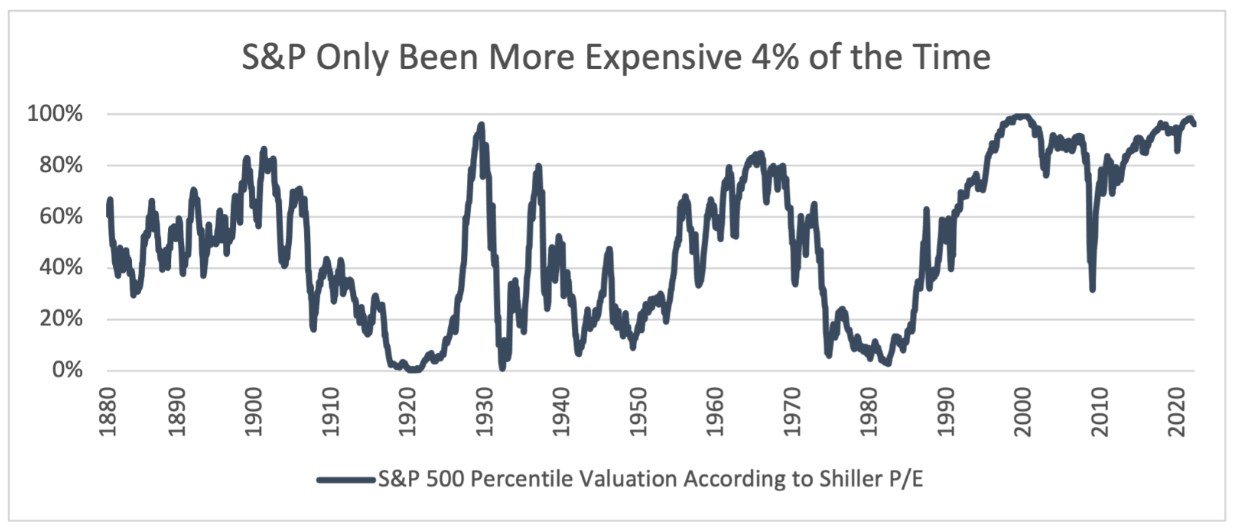3 things to consider as equities keep falling (and 2 signs of the bottom)
Shares have had an awful start to the year. Portfolios are bleeding and savers are scared. Forget about making money, the problem is holding on to it.
For years US shares, especially tech, have been wonderful investments. In the decade to the end of 2021, the tech-heavy Nasdaq Composite returned over 21% annually – a rate at which money doubles in just over three years. Whenever US shares sold off, the Pavlovian response was to buy the dip, pouring in money because this had paid off repeatedly.
In 2022, this approach stopped working. In the first six months of this year, the Nasdaq was down 30%. The S&P 500, the broad US share index, was down 21%.
Despite the big sell-off, there are three things to consider to ensure portfolios can withstand further downside:
- US shares are still costly,
- The economy will deteriorate into the second half of 2023, and
- By fighting inflation, the Federal Reserve will hurt assets more than help them.
US shares are still expensive
War in Ukraine, the end of quantitative easing, inflation and an impending economic slowdown have all had an impact on share prices. But the driving force behind the sell-off so far has been the rise in interest rates. Higher rates make future cash flows less valuable and cut the amount investors will pay for them.
Even now the S&P 500’s valuation is extended, according to one of the most widely followed data sets. The Shiller Price-Earnings Ratio, a measure that adjusts earnings for inflation and smooths out cycles, was 30.8x at the end of May. This measure has only been higher for a total of 4% of its more than 140-year history (chart below).

At this level, a key question is whether the valuation has come down sufficiently to compensate for falling corporate earnings, which is the next challenge for the market.
The domino effect of falling company profits
Unlike physics, economics is not subject to the hard laws of science. If a calculator falls from a desk, we know it is heading toward the floor. In economics certainty is slippery. It is probabilities that count, and relationships between different economic indicators that make events more or less likely. Some of these relationships are warning of an economic slowdown and a fall in corporate profitability.
There is a domino effect: interest rates rise, economic growth slows, and corporate earnings fall. In between the rising rates and the slowing growth are proven early warning signs known as leading economic indicators (LEIs).
One of the most reliable LEIs is the Institute of Supply Managers’ (ISM) New Orders Index. A rise in US 10-year bond yields usually comes 18 months before a fall in the ISM. And the size of the rise in yields is a guide to the scale of the future fall in the ISM. Looking at yields, the ISM could move from last year’s highs of over 60 to as little as 35 in the second half of next year.
This would mean a sharp contraction in economic growth and a potential fall in corporate earnings of 35% or more. Given the valuation, it would be hard to argue that investors have priced this into shares.
Central banks aren't coming to the rescue any time soon
Facing previous slowdowns and falling markets monetary authorities have given support by lowering interest rates and printing money. This time things are going in the opposite direction. June saw the end of US quantitative easing and only recently the Federal Reserve raised its overnight Fed Funds rate by 0.75% as it attempts to put a lid on inflation.
There is an argument that one-offs are temporarily pushing up prices. But for all the undoubted damage being done by the disruption of global supply chains and by the terrible war in Ukraine, investors should not rely on a resolution of either to bring down inflation on their own.
Services comprise the vast majority of the consumer price index, and this is largely immune from supply chain disruption or war. It is wages that drive Services and with a labour market as tight as it is, these are trending upwards.
What might put a floor in the market?
The data since 1950 show that one of two events is probably going to signal the end of this sell-off.
The first is when monetary authorities change to policies that support the economy and markets. As we have seen, this is a way off. After all, there is not a central banker in the world that wants their name associated with a return to the inflation-wrought chaos of the 1970s.
The second is when LEIs stop falling. At this point, investors will be able to anticipate a recovery in both the economy and corporate profitability. This looks like it will happen in the second half of next year at the earliest.
None of the above means the market cannot recover in the near term. In fact, it would be almost more surprising if there was not a bounce after a sell-off like this year’s so far. “Markets do not go down in a straight line” is a well-known saying for a reason. But whatever the short-term direction, the long-term outlook is poor.
So, what to do?
If you believe the market can fall further, it makes sense to avoid being in assets that move in the same direction as the market and with the same or greater magnitude. The shorthand for this is to prefer low over high beta. High beta at times has its place, but today is anything but one of those times.
In a high inflation environment, it also pays to own assets that allow you to recoup your investment sooner rather than later. One of the reasons value stocks have performed well over the last year is because they do exactly that. Diversifying to regions other than the US and sectors other than Tech can offer greater options to reduce your payback period.
High-yielding assets also fit the bill. Investors would be well-served to focus on income as a component of returns which need not just be dividends and interest on cash but also option premium. Consistent income creates a return when growth is scarce, helping protect capital and smooth the journey in these volatile times.
A little certainty can be empowering, especially in volatile times
For more than 16 years Talaria has been delivering a greater certainty of returns through its unique and alternative approach to global equity investing, with over 9% p.a. average income for the last 10 years, low volatility and lower market risk.
4 topics

